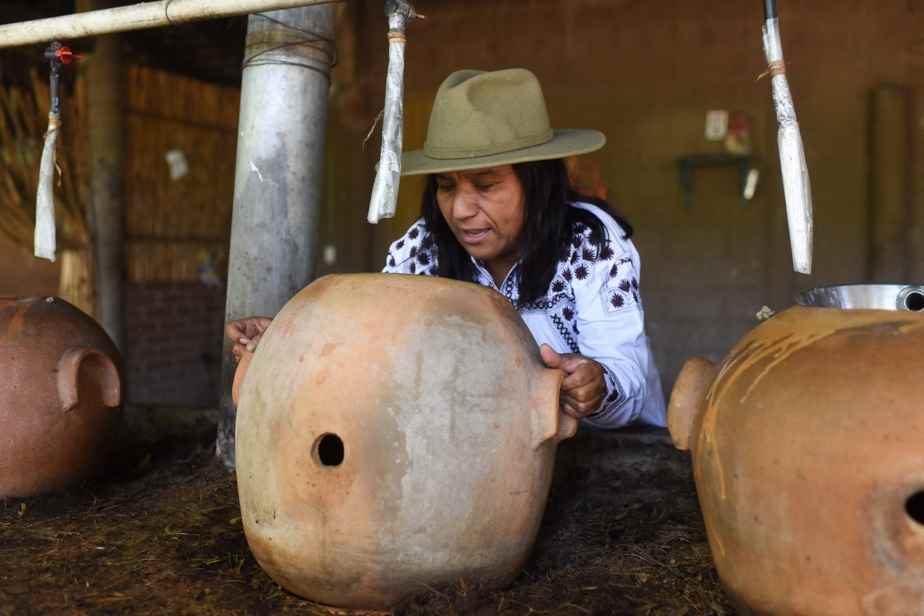(Villa Sola de Vega) At a glance, Sosima Olivera can assess the quality of an agave, the plant of mezcal, the fashionable Mexican alcohol whose artisan producers fear the bitter fruits of international success and overexploitation .
Posted at 10:52
“The bottle (of mezcal) is a summary of everything we’ve been doing for years,” says Sosima, surveying her plantations of thick, giant, climbing, spiky green leaves — not to be confused with cacti — through the hills of Sola de Vega, in southwestern Mexico.
Sosima, 50, leads a collective of “mezcaleros” in the state of Oaxaca, a shortcut in Mexico between the Pacific coast and the southern end of the Sierra Madre, with traditions authentically maintained by the Zapotec and Mixtec communities.
Oaxaca is the birthplace of mezcal, which is gaining popularity in cocktail bars in the United States, Canada, Spain, France and Germany.
Exports rose from $19.7 million in 2015 to $62.9 million in 2020, according to official data.
The brands often allude to the euphoria provided by an alcohol that heats the entrails to 40 or 50 degrees: “Viejo indecente” (indecent old man), “Pierde almas” (lost souls), “Mil diablos” (a thousand demons).

PHOTO PEDRO PARDO, AGENCY FRANCE-PRESSE
At a glance, Sosima Olivera can assess the quality of an agave, the mezcal plant.
“Mezcalerias” sniffed out a bargain around the Santo Domingo cathedral in Oaxaca-ville, the stronghold of great Mexican artists of the XXe century (Francisco Toledo and Rufino Tamayo) taken over by tourists.
These drinking establishments serve mezcal in thimbles despite the local saying that it is better not to be taken literally, indeed: “For every evil, a mezcal.” For every happiness too. She if there is no solution, a liter and a half”.
Without agave no mezcal
Mezcal derives from agave — also called maguey, plants of the Asparagaceae family — as does tequila, the only daughter of blue agave in the state of Jalisco, further north.
More refined in taste, mezcal uses different types of plants and its artisanal production takes more time to elaborate.
Some plants require 13 and 15 years to mature, and even up to 17 years in the case of “tepeztate”.
Far from rejoicing in the worldwide notoriety of mezcal, Sosima worries about the consequences of the boom in commercial demand.

PHOTO PEDRO PARDO, AGENCY FRANCE-PRESSE
Some plants require 13 and 15 years to mature, and even up to 17 years in the case of “tepeztate”.
“If there is a need for more plants, there is more exploitation of the land, the landscapes, the biodiversity, the wood”, she analyzes, facing her clay jars in which she distils an eau-de-vie of his own brand, Fane Kantsini (Three hummingbirds in chontal, his native language).
“Very little effort is made to conserve agave species,” laments another producer, Graciela Angeles, 43. “Without maguey, there is no mezcal,” she asserts, a saying as true as the one in vogue in the “mezcalerias” of Oaxaca-capital.
Graciela cultivates multiple varieties of grains and seeds in a huge greenhouse.
It details the complex process of making the liqueur, the success of which largely depends on the flair and talent of the master “mezcalero”.
Another danger: some artisanal “palenque” (distillation workshops) are in fact only subcontractors for major brands, with the arrival of large amounts of capital in the lucrative spirits trade. A brand like 400 conejos (400 rabbits) is well established in airport duty-free shops.
On average, a 750ml bottle costs $40 in Oaxaca.
In contrast to this business model, the mezcal of Sosima and Angeles is the result of a slow process. “Small producers like us will always exist in the villages,” hopes Sosima. Producers who follow sustainable agriculture, sowing little, but well, she explains in substance.
The two female mezcal producers hold tasting sessions to educate consumers.
“What’s behind mezcal, I learned after falling in love with the flavor,” said Christopher Govers, a tourist at a mezcal party that drew several hundred people to Oaxaca-capital. Behind him, at the height of the party, two men stagger past.
